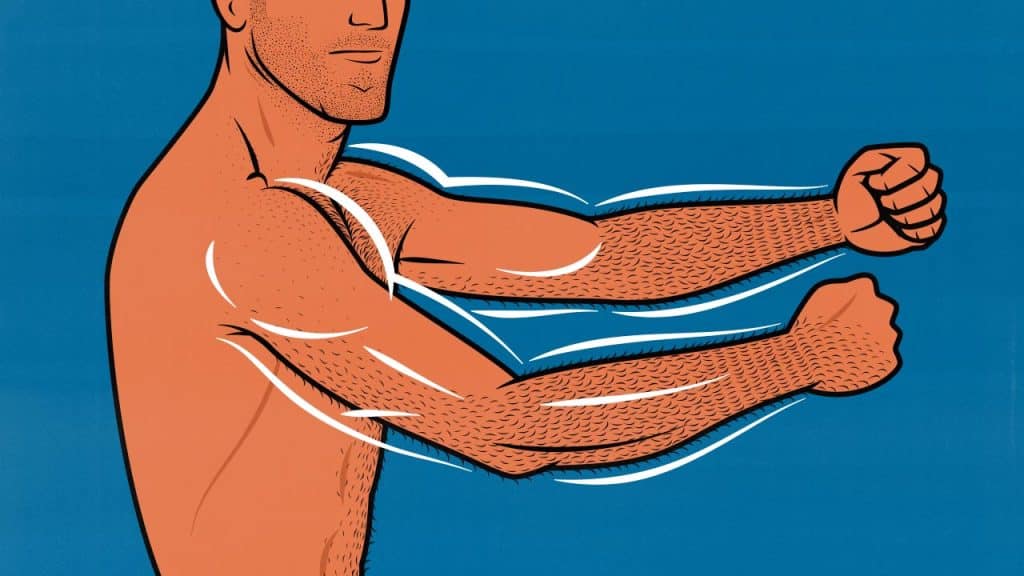
How to Build Bigger Arms
I’ve managed to bring my arms from 10 inches up to 16 inches. But I got off to a rough start. During my first two years of successful bulking, I gained 40 pounds at 11% body fat, bringing my bench from 65 to 225 pounds and doing chin-ups with 50 pounds around my waist. Yet, despite my progress, I had only added 2 inches to my arms. My arms were still 1.3 inches smaller than average, and the average man doesn’t even exercise!
That’s when I realized my mistake. I was relying on compound lifts to bulk up my arms. When I finally added proper arm exercises to my workout program, my arms quickly shot up to 14 inches, then gradually climbed to 16 inches. Surprisingly, my bench press started going up again. I was finally able to bench 315.
We’ve used these same methods with over 10,000 skinny clients and millions of readers. If you add these methods to your workout routine, you can expect to add around 2 inches to your arms within the next 6 months. That’s what our clients gain, on average.
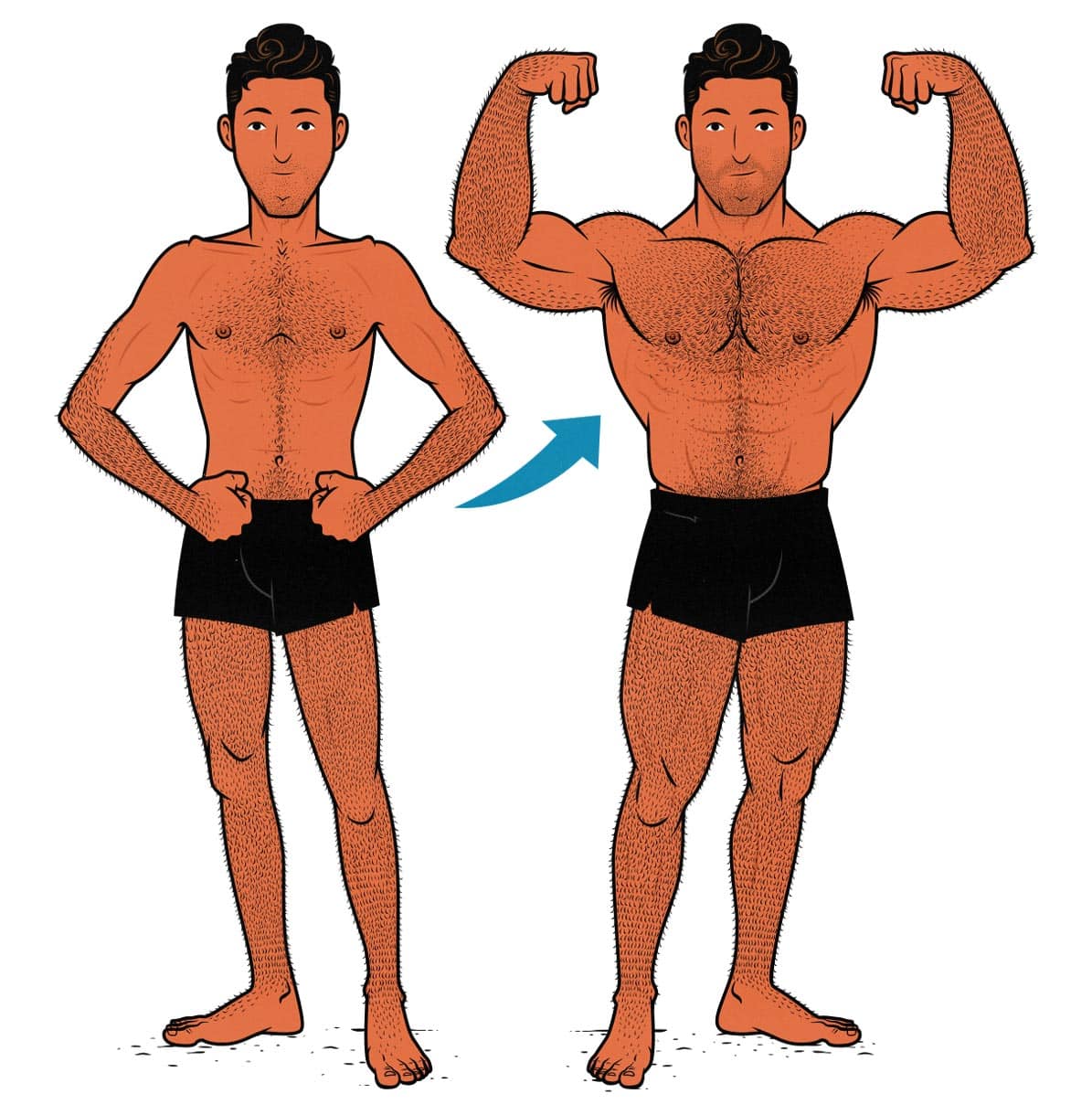
Arm Muscle Anatomy
There are a few different arm muscles that we care about. There are the big muscles in our upper arms: our shoulders, biceps, brachialis, and triceps. And there are big muscles in our forearms: our wrist flexors, wrist extensors, and elbow flexors.
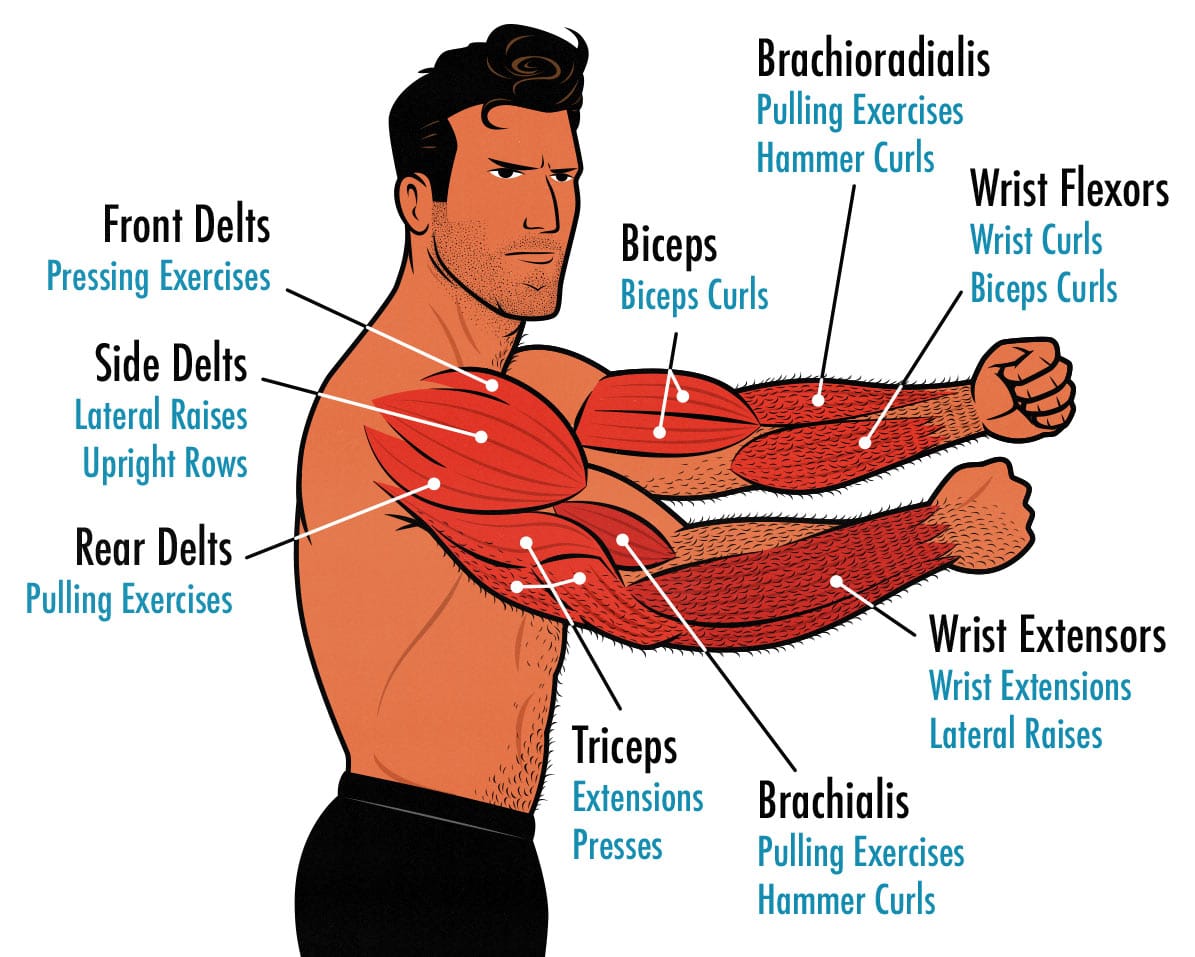
We’ll go into more detail in a second, but here are some examples of exercises for each of the muscles in our arms:
- Shoulders: pulling and pressing exercises, including chin-ups, rows, upright rows, overhead presses, and bench presses.
- Biceps: pulling and curling exercises, including chin-ups and biceps curls. Biceps curls align better with the function of our biceps.
- Triceps: pushing and elbow extension exercises, including the bench press, overhead press, skull crusher, and overhead extension. The extension exercises align better with the function of our triceps.
- Brachialis: neutral-grip pulling and curling exercises, including neutral-grip chin-ups, dumbbell rows, and hammer curls.
- Forearm elbow flexors: overhand pulling and curling exercises, including barbell rows, pull-ups, and reverse curls.
- Wrist flexors: biceps curls and wrist curls.
- Wrist extensors: lateral raises and wrist extensions.
Compound lifts are often thought to give us the most bang for our buck, but that’s not true here. Most compound lifts emphasize the muscles in our torsos. For instance, the bench press is better for our chests and shoulders than for our triceps. For building bigger arms, the smaller isolation lifts are often quite important. (We’ll explain why in a moment.)
The Average Arm Size
According to data collected by the CDC, the average American weighs 197 pounds and has a biceps circumference of 13.3 inches. But this is a site for skinny guys. We use our own stats. The average guy who starts our Bony to Beastly Program weighs 148 pounds and has arms measuring 12 inches. By the end of the program, that goes up to 173 pounds and 14 inches, on average.
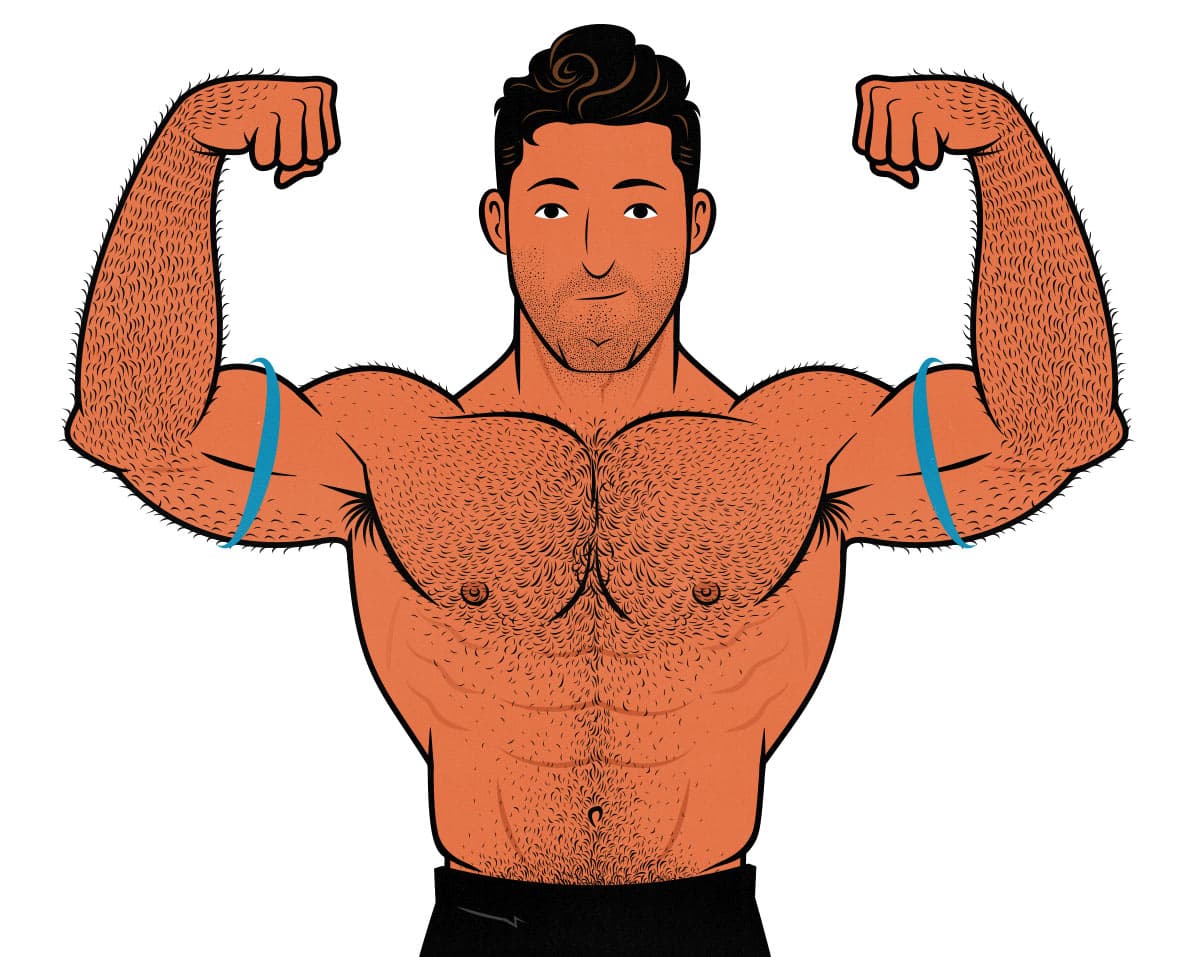
How Big Should Your Arms Be?
To figure out the ideal biceps size, there are two good sources we can look at. The first is an attractiveness study by Sell et al showing that the more muscle you build, the better you’ll look—at least when building muscle naturally.
Following that logic, the best way to improve the appearance of your arms is simply to build them as big as you can. At a certain point, you’ll butt up against your genetic limit. That’s your ideal arm size. Most natural lifters cap out at 15–18 inches. Guys who start off skinnier might cap out at 14–17 inches.
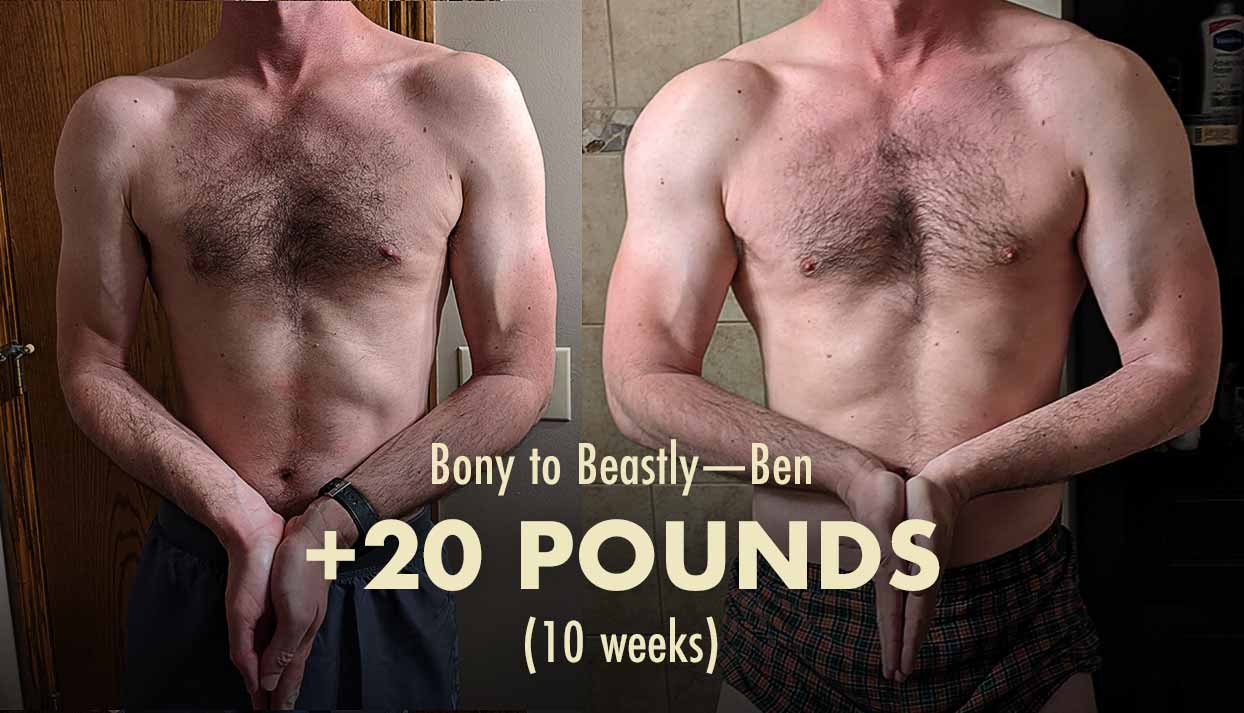
For a slightly different perspective, we have the research of Casey Butts, Ph.D. According to him, your biceps should be proportional to your waist, and your waist should be lean. So to start, measure (or estimate) the size of your waist when you’re at 8–15% body fat. It will probably be in the neighbourhood of 28–34 inches. If in doubt, you can use 31 inches as your default.
The ideal arm size:
- Ideal biceps circumference: waist circumference × 0.5
- Ideal forearm circumference: biceps circumference × 0.8
These measurements line up with what you might find on the statue of an Ancient Greek warrior. Keep in mind that these are loose estimations, though. Feel free to give or take 10%. With that little bit of wiggle room, here are the ideal proportions for a man who has a 31-inch waist at 12% body fat:
- Waist size: 31 inches
- Biceps size: 14–17 inches
- Forearm size: 11–13.5 inches
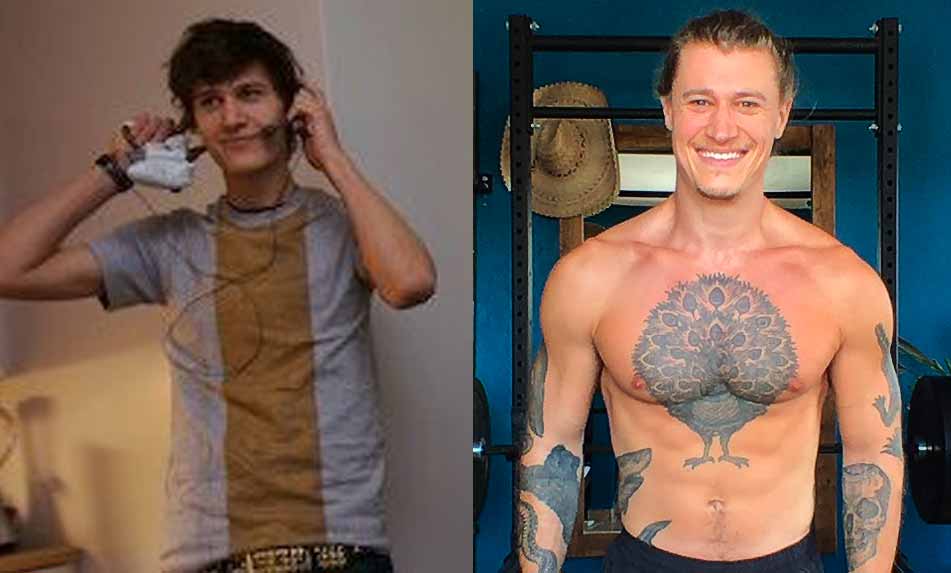
These proportions also line up fairly well with how much muscle a skinny guy can expect to build naturally. To give you an idea of what that looks like, here’s a photo of me when I had a 31-inch waist, 15.5-inch biceps, and 12.5-inch forearms:
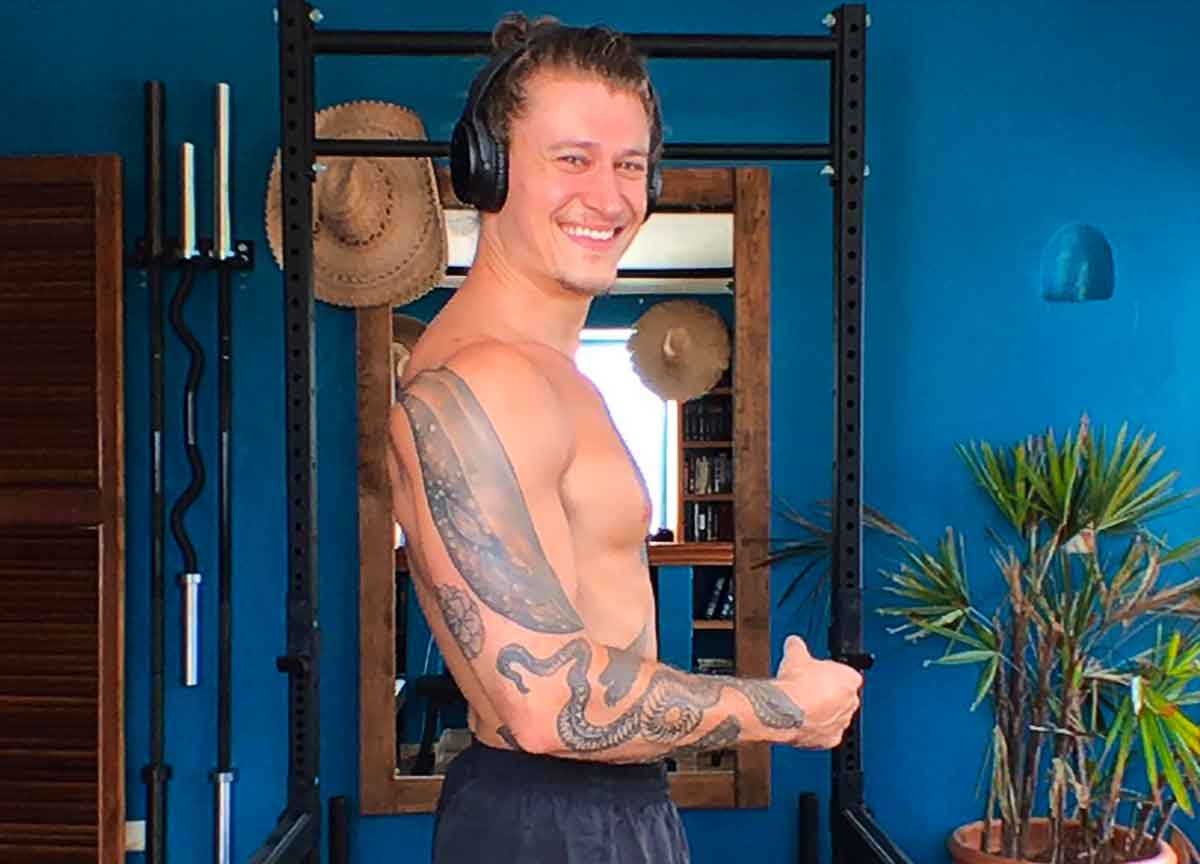
The good news is that these proportions are often realistically achievable, even for naturally skinny guys. No matter how lanky your arms are now, you can fill out the sleeves of a t-shirt. Not just the sleeves of a slim-fit t-shirt, either. Even those box-cut ones that hang around your waist like a tent.
How Long Does it Take to Build Bigger Arms?
On average, our members can add 1 inch to their arms for every 10 pounds they gain. Different guys bulk at different paces, but a good rule of thumb is to gain around a pound per week. Adding an inch to your arms is noticeable. Two inches tends to be the sweet spot where other people start to comment. So, if you want to add 2 inches to your arms, it will take you around 5–6 months.
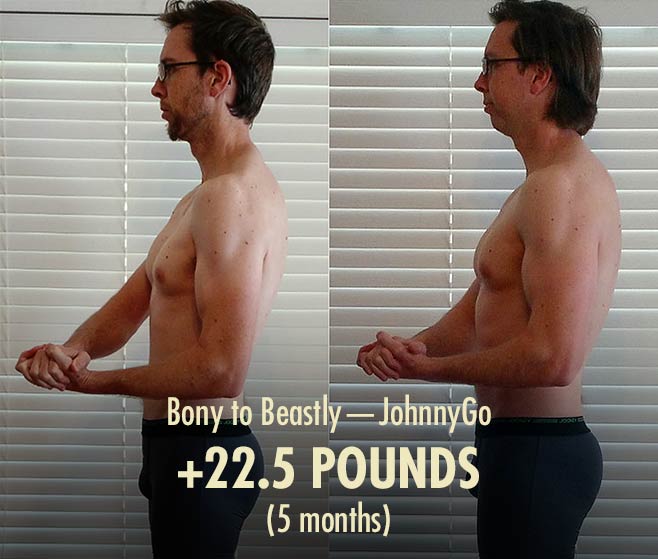
If you’re like me, trying to go from 10-inch to 16-inches arms, that’s a longer road. It might take you a few bulks to get there. Your newbie gains will grind to a groaning halt. You’ll need to march slowly through the intermediate badlands. But with every 1–2 inches you add, you can expect your arms to look dramatically more muscular.
On the bright side, when you’re skinny, even small changes in muscle size can be noticeable. You may see improvements in your arms within days of your first arm workout. That’s because your muscles are inflamed from your training. Your body may start storing more glycogen there. It isn’t bonafide muscle growth yet, but it looks cool.
Why Do Skinny Guys’ Arms Lag Behind?
There are a few different approaches to building muscle. If you look at the typical bodybuilding website, you’ll see a maximalist approach, where they train every muscle with a cornucopia of compound and isolation exercises. This approach is great for stimulating muscle growth. The problem is, it’s also long, gruelling, fatiguing, and inefficient. Is doing barbell curls, preacher curls, and spider curls one after another on “arm day” the best way to build bigger arms? Probably not.
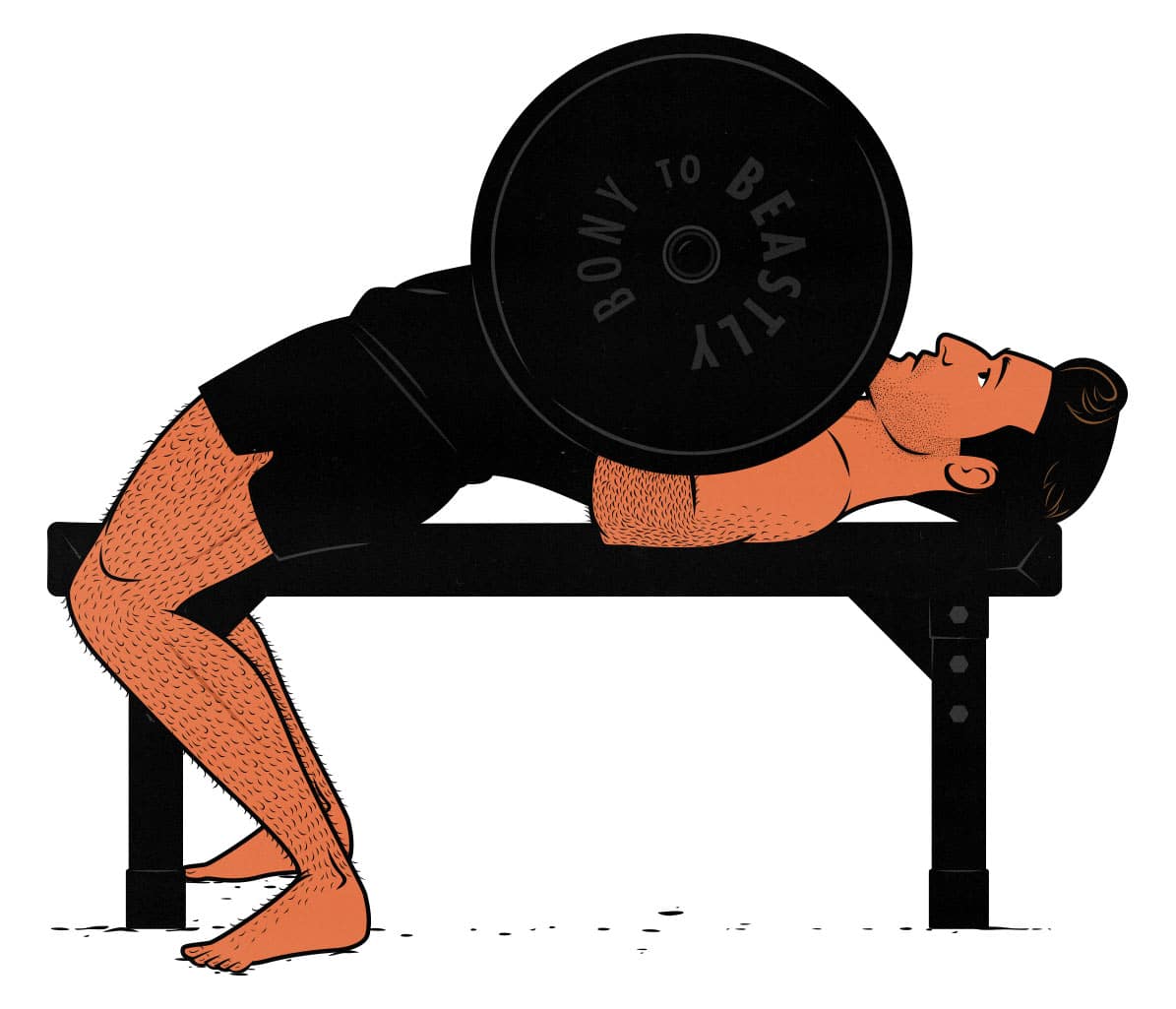
Others take a minimalist approach, focusing on just the foundational muscle-building exercises: the squat, bench press, deadlift, overhead press, and chin-up. This is what you’ll see in the typical beginner strength training program, such as Starting Strength or StrongLifts 5×5. These compound exercises are highly efficient, training dozens of muscles at once. The trouble is, some muscles inevitably lag behind. Those lagging muscles are often in our arms.
To show you what we mean, let’s take a look at two of the biggest muscles in your arms—your biceps and triceps.
Why Biceps Lag Behind
The biceps are famous for being the muscles that flex our arms. And that’s true. They do. But they actually cross two joints: the elbow and shoulder joints. This introduces a problem.
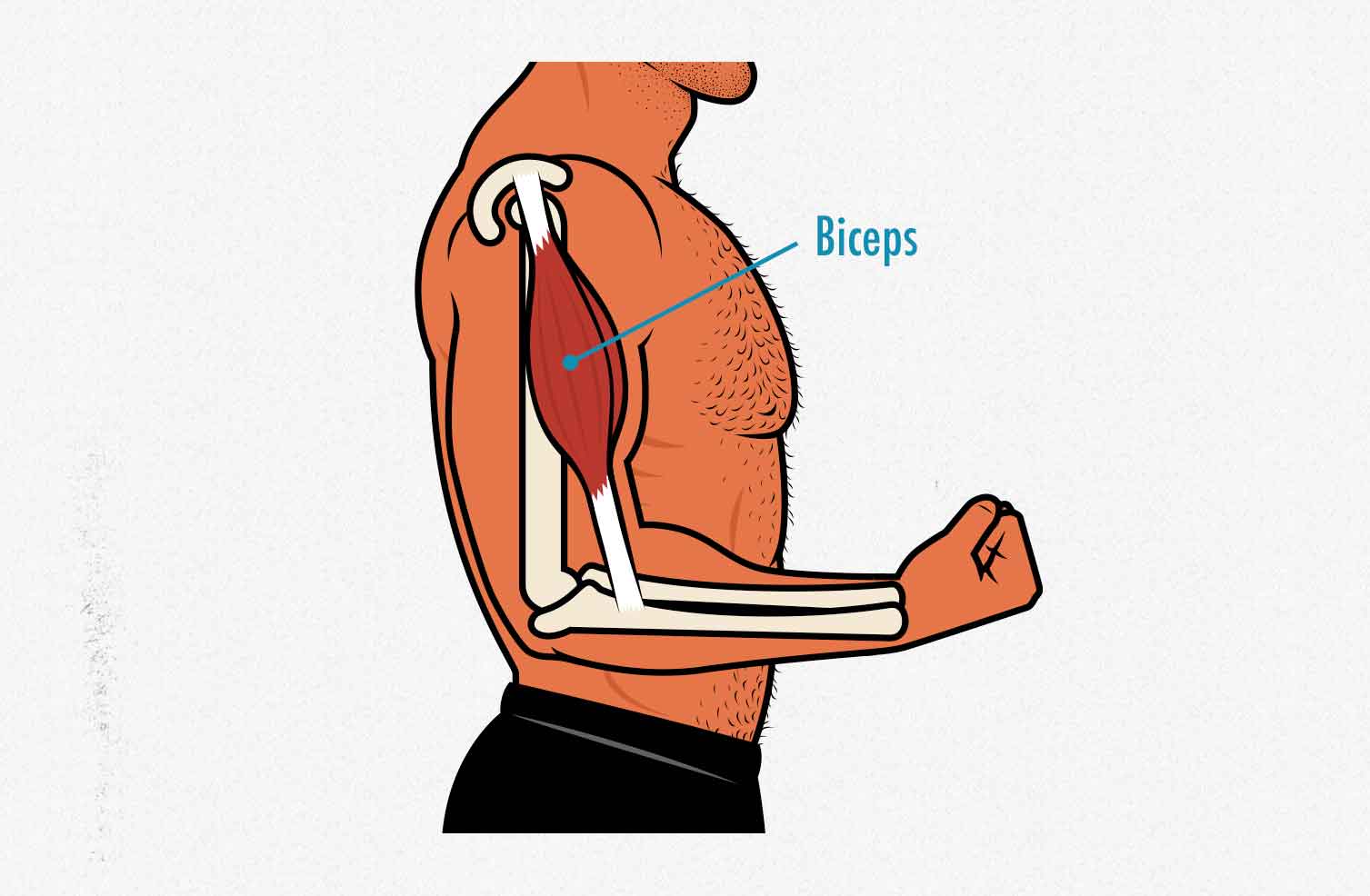
When you contract your biceps, they flex both your arms and your shoulders. The full range of motion for your biceps looks like this:
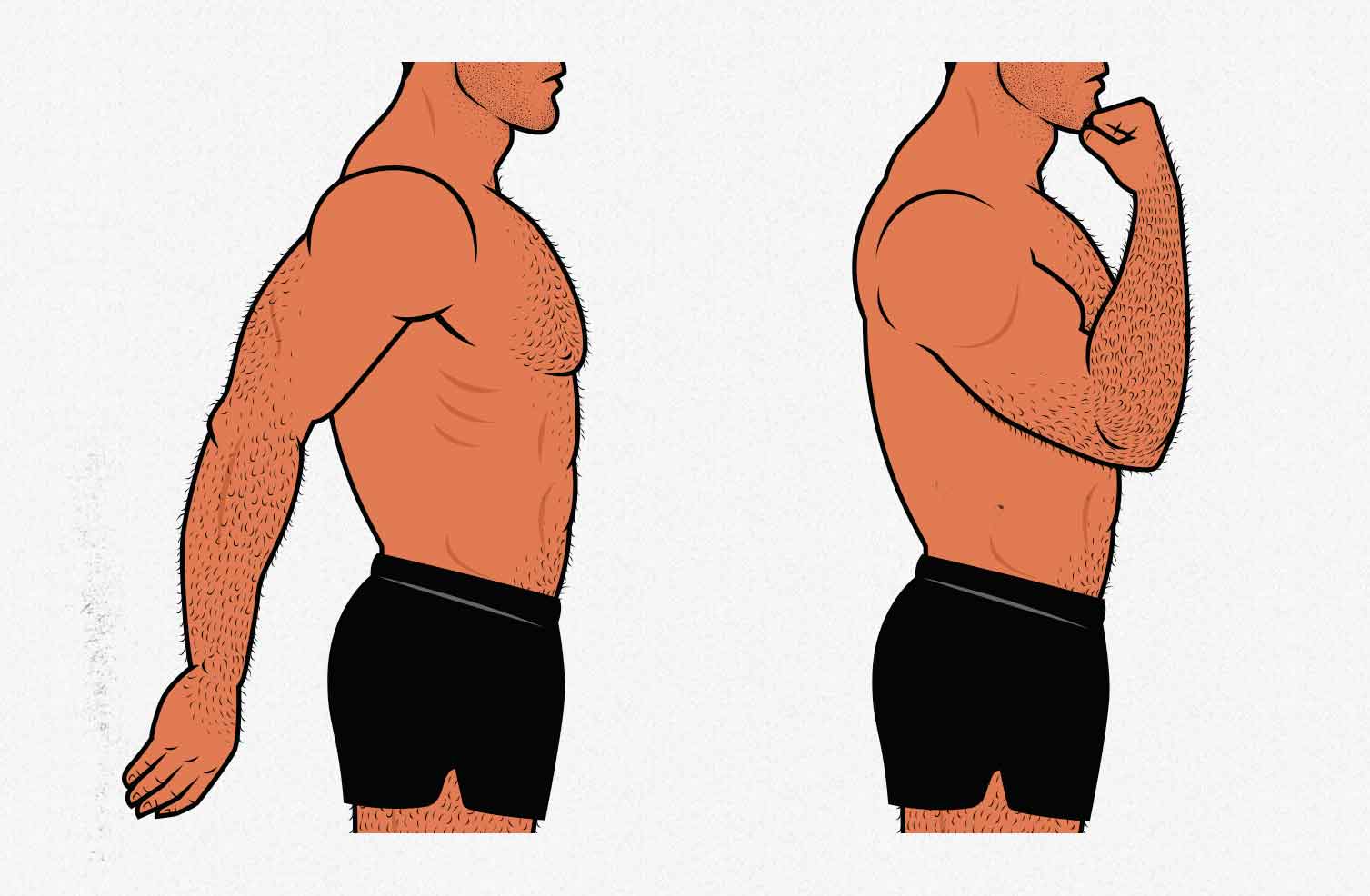
When your arms are open and behind you, your biceps are stretched. When your arms are closed and in front of you, your biceps are contracted. Now, why does this matter?
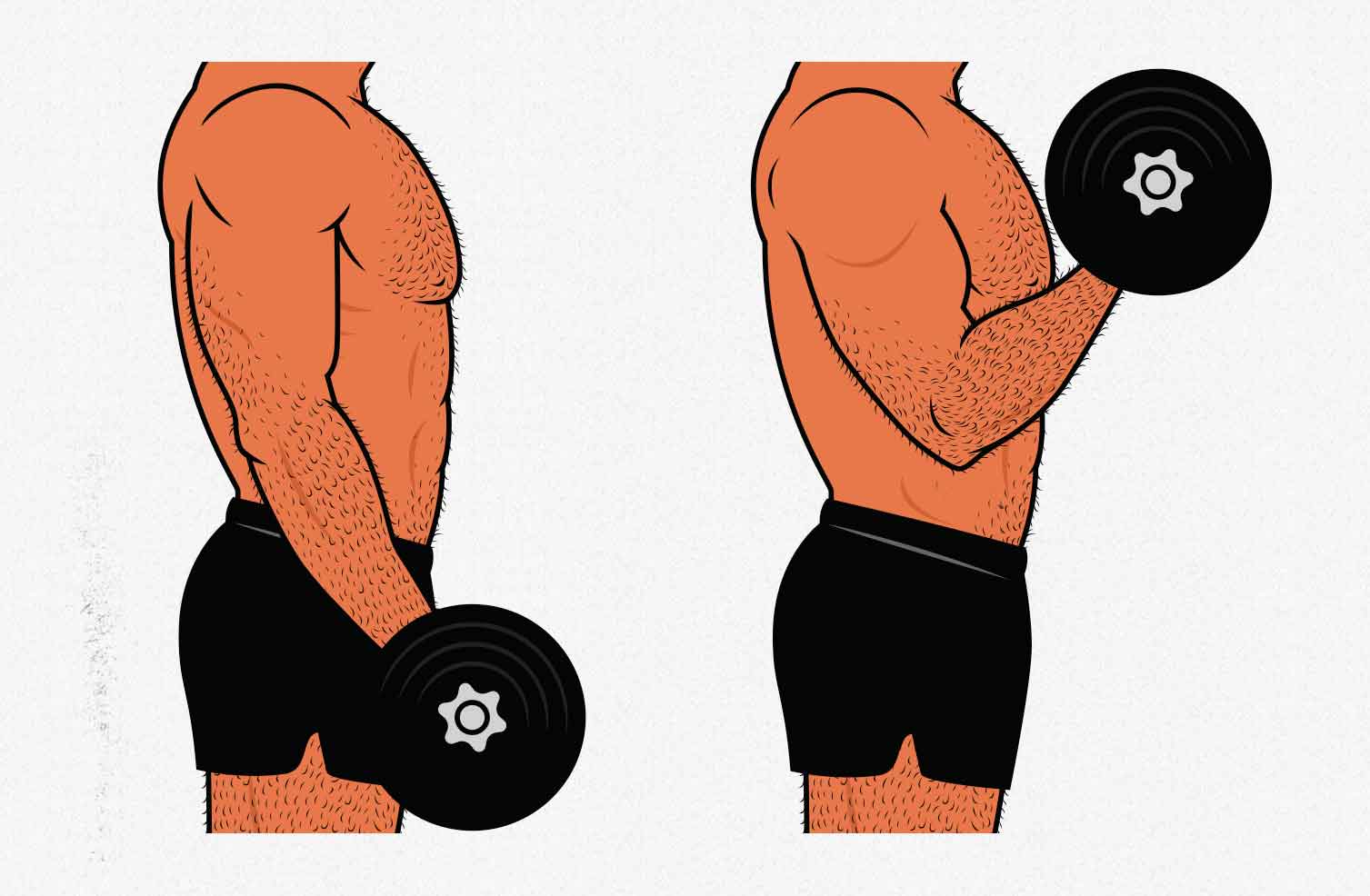
With a biceps curl, you’re working your biceps in a way that suits them. You’re flexing your arms to curl the weight up, and your elbows are free to drift forward a bit. Your biceps start in a stretched position and finish in a contracted position. Sweet.
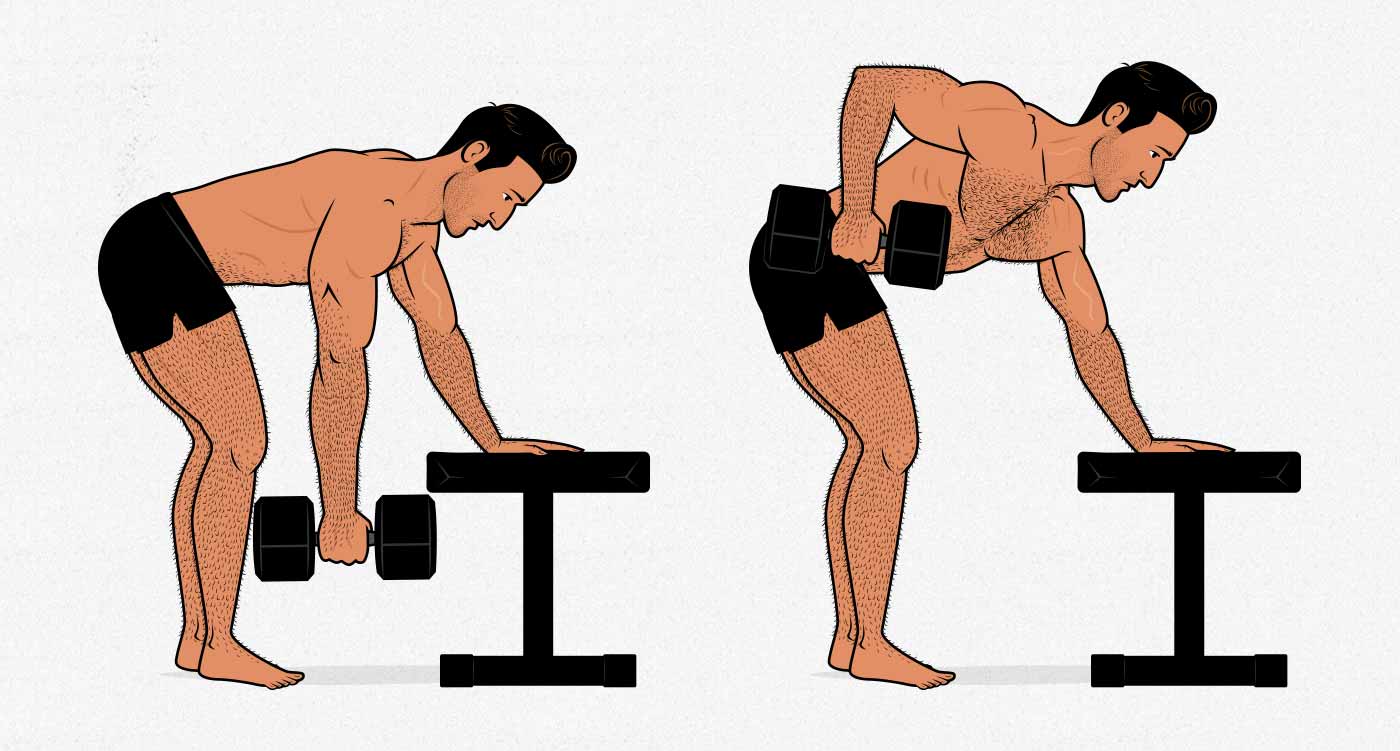
Now, here comes the problem. With compound lifts that work your biceps, such as rows and chin-ups, you’re pulling your elbows back. As you shorten your biceps by flexing your arms, you’re lengthening them at the shoulder joint. That’s not good. And it gets worse.
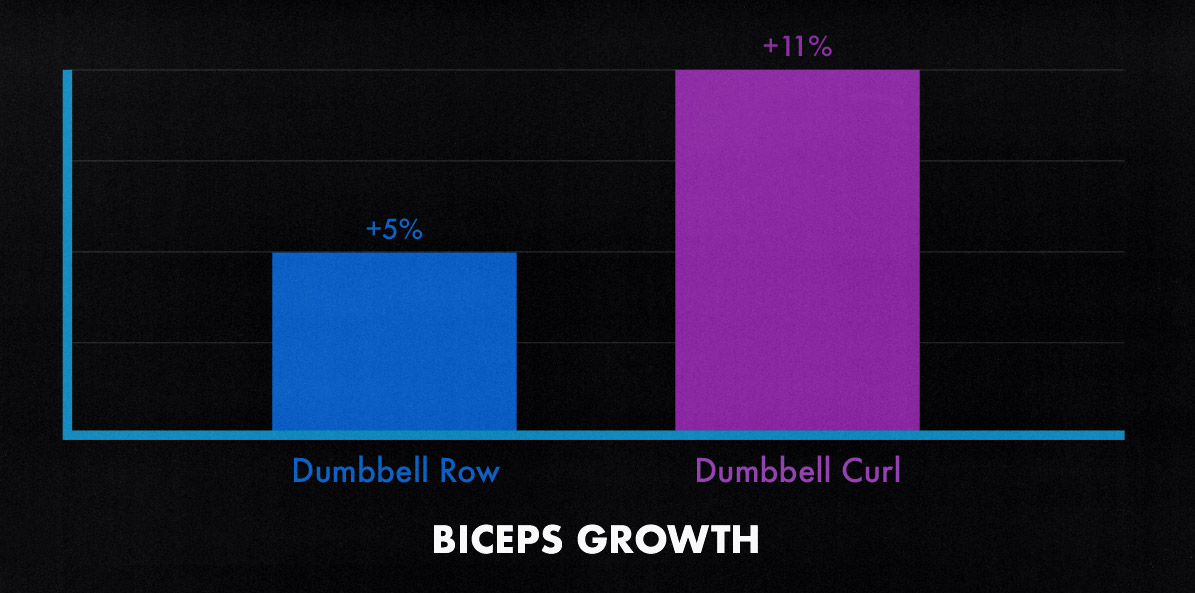
Mannarino et al. compared rows with biceps curls, finding that biceps curls stimulated nearly twice as much biceps growth as rows. These weren’t normal rows, either. They were done with an underhand grip in an attempt to stimulate more biceps growth. It didn’t work.
Part of the problem with using rows for biceps growth is the movement at the shoulder joint. But there’s also the problem of your biceps not being the limiting factor. When doing rows, your back will give out before your biceps do, meaning that you won’t be bringing your biceps close enough to failure.
Now, keep in mind that rows still stimulate more muscle growth overall. They’re fantastic for building muscle in your upper back. The thing is, if you aren’t adding in plenty of biceps curls, your upper back will grow much faster than your biceps. Your arms will lag.
Why Triceps Lag Behind
Your triceps are similar to your biceps. They’re best at opening your arms, but they can also pull your elbows back. So when you’re thinking of triceps exercises, you should be thinking of movements that extend both your elbows and your shoulders, like so:
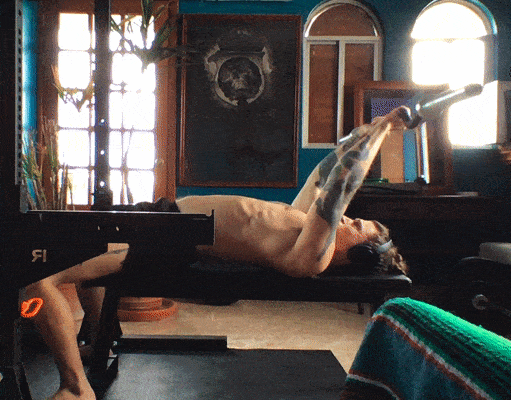
The problem is that most compound lifts have us flexing at the shoulder joint, interfering with our ability to contract our triceps. Think of a push-up or bench press. In both of those lifts, we’re extending our elbows while flexing our shoulders. We’re contracting our triceps at one end while lengthening them at the other. No good.
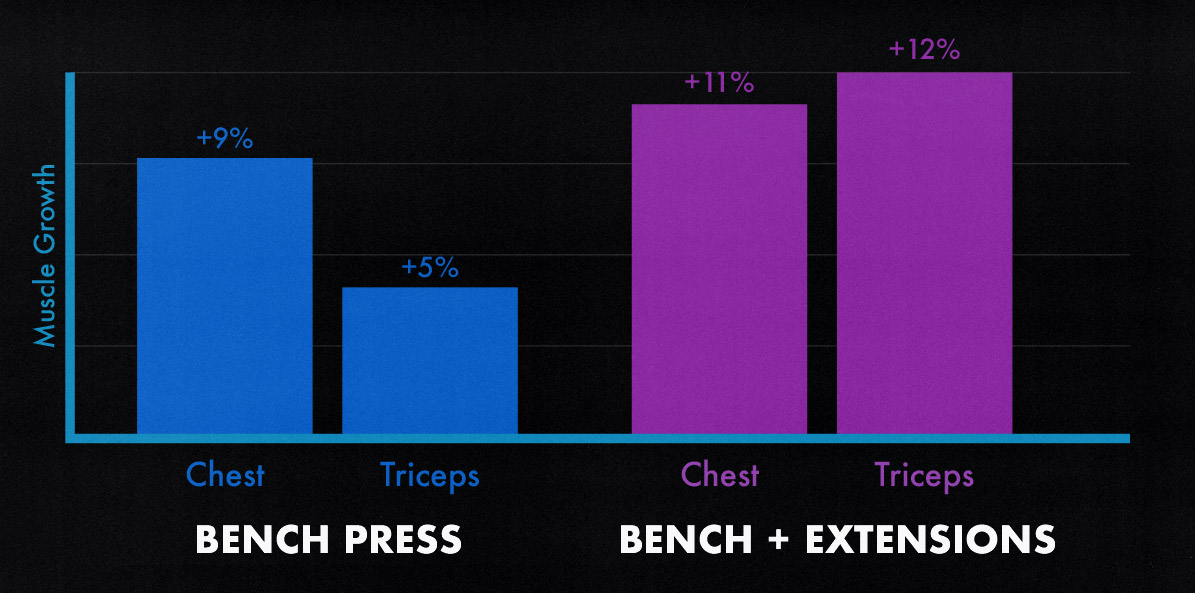
Brandão and colleagues compared the bench press with skull crushers (aka skullcrushers, skull overs, and lying triceps extensions). They found that skull crushers stimulated about twice as much triceps growth as the bench press. So, again, we’re seeing that choosing lifts that match the function of our muscles is crucial for bulking up those muscles, yielding about double the muscle growth.
The bench press is great for building a bigger chest. It matches the function of your pecs perfectly. It’s my favourite lift. The trouble is, if you aren’t adding in plenty of skull crushers, your chest will grow much faster than your triceps. Your arms will lag. What surprised me most, though, is that when I started adding more skull crushers into my workout routine, my bench press took off. I went from benching 265 to 315—an extra 50 pounds!—over the course of just a few months.
The Principles of Arm Training
How to Lift for Muscle Size
The first principle is specificity. The first thing we want to do is build our arm workouts around the lifts that are best for bulking up our arms: shoulder presses, biceps curls, triceps extensions, lateral raises, wrist curls, and so on. But we also want to make sure that we’re doing those exercises in a way that’s designed to stimulate muscle growth.
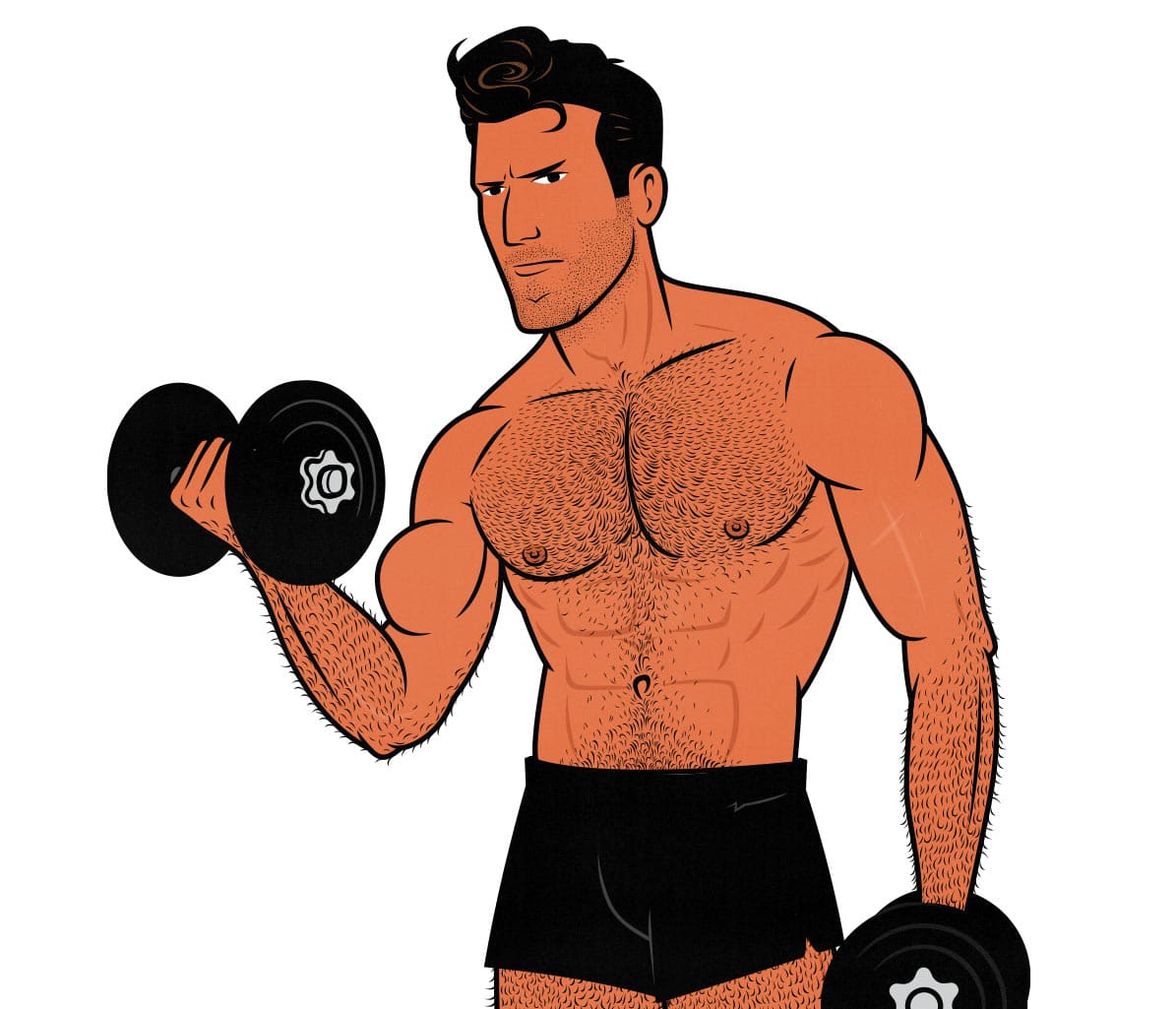
In the world of weight training, a lot of different terms are thrown around. To the uninitiated, both “bodybuilding” and “strength training” can refer to lifting weights to build bigger and stronger muscles. But as you get deeper into lifting culture, the terms begin to diverge. Strength training is rooted in the sport of powerlifting, designed to increase 1-rep strength on the bench, squat, and deadlift. Bodybuilding is rooted in the sport of bodybuilding, designed to help you win a posing competition on stage. It includes building a wider quad sweep, dying your skin the right shade of orange, and choosing the Speedo that best shows off your glute striations.
The type of training we’re interested in is hypertrophy training. It means “muscle growth” training. It’s the type of training designed to help you build bigger, stronger muscles. Like a powerlifter, you’ll build a bigger squat, bench, and deadlift. But you’ll also be growing stronger at a variety of others lifts, ranging from the chin-up to the biceps curl. And you’ll increase your maximal strength. But you’ll also get stronger at sets of 8, 12, and 15 reps. And you’ll look rad in a Speedo, but you won’t be forced to wear one.
Here’s how to structure a good hypertrophy training workout routine:
- Choose good exercises: it’s best to build your overall workout routine on a foundation of compound lifts. But if your goal is specifically to build bigger arms, then include arm isolation exercises as well: biceps curls, triceps extensions, and forearm curls.
- Use a deep range of motion: our muscles grow much faster when we challenge them at long muscle lengths (systematic review). For our arms, the exercises with the deepest range of motion are incline curls for our biceps, overhead extensions for our triceps, and seated forearm curls for our forearms. We can also ditch the exercises that emphasize the contraction, such as spider curls and resistance band exercises.
- Do enough sets per week: most research shows that doing somewhere between 9–18 sets per muscle per week is ideal for building muscle. That might mean doing 5–9 sets of compound lifts and 4–9 sets of each of your arm isolation exercises each week.
- Do enough reps per set: anywhere from 4–40 repetitions per set will build muscle, but we tend to gain more muscle more easily when lifting in the 6–20 rep range. This is especially true with arm isolation exercises, where it’s often safest and easiest to do 8–15 reps per set.
- Train often enough: to maximize our rate of muscle growth, we want to train our muscles 2–4 times per week. Maybe that means doing biceps curls, triceps extensions, and forearm curls every Monday and Friday.
- Train hard enough: to make sure that we’re challenging our muscles, we need to bring our sets within 0–3 reps of failure on most sets. Arm isolation exercises tend to be fairly safe and aren’t likely to cause much overall fatigue, so feel free to bring them closer—or all the way—to failure.
- Outlift yourself: we don’t need to hit PRs every workout, but we should always try to either add weight to the bar or eke out extra reps.
To summarize, if you want to build bigger arms as fast as possible, it’s best to train specifically for muscle size. To do that, include 2–3 sets of biceps curls, triceps extensions, and forearm curls alongside your compound lifts. When doing those arm isolation exercises, lift in a moderate rep range (6–20 reps per set) and bring those sets within 0–1 reps of failure. Ideally, do this at least twice per week.
The Importance of Getting Stronger
One of the biggest mistakes I made when trying to bulk up my arms was forgetting about the importance of progressive overload. I didn’t forget about getting stronger overall. I gradually gained strength on the bench press, squat, deadlift, overhead press, and chin-up. No, I forgot to focus on getting stronger on my arm isolation exercises.
By the time I had gained my first 40 pounds, my arms had gone from 10 inches to around 11.5–12 inches. By this point, I had quadrupled my strength. I was benching 225 for reps and doing sets of chin-ups with 50 pounds around my waist. I’d been doing some biceps curls and triceps extensions, too, but they were just an afterthought. I’d been relying on the compound pushing and pulling exercises to train my arms. And my arms did look better. I had made some progress. But I was disappointed in how little they’d grown in proportion to my chest and back.
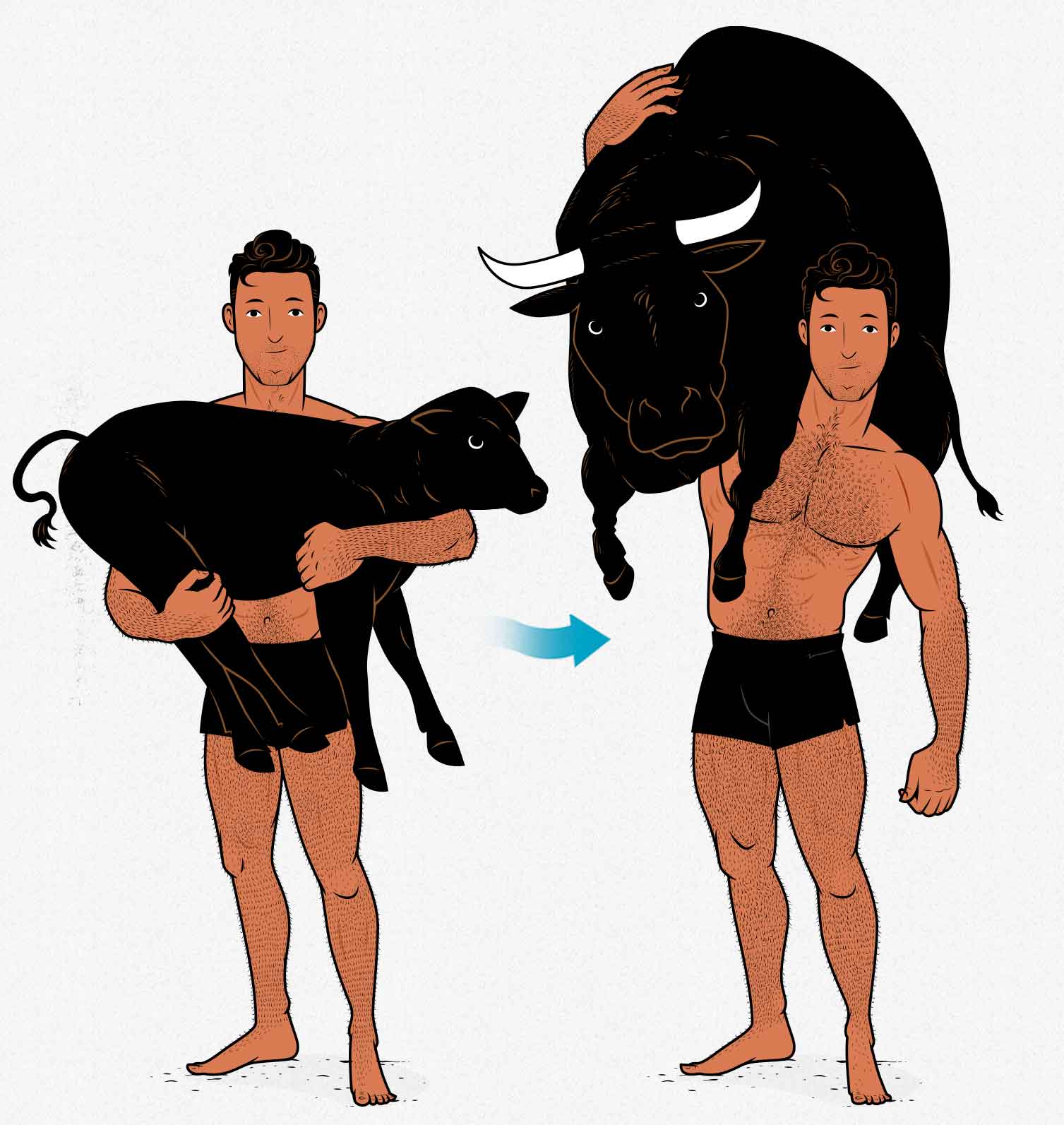
The trick is, when you have the specific goal of building bigger arms, you need to approach your arm exercises with the same fervour as your compound exercises. You need to work on adding weight or adding reps over time. Fight for progress on your curls and extensions, not just your presses and pulls. This means approaching each workout with a plan, writing down what you’re lifting, and trying to outlift yourself next workout. If you did barbell curls with 85 pounds for 8 reps the last workout, add a bit of weight or try to get an extra rep.
Give Your Arms Greater Priority
In a standard workout program, compound exercises take precedence; arm exercises come at the end. And that’s good. No sense tiring out your arms when you still have compound lifts to do, right? But if your arms are what you’re most desperate to grow, you may wish to move them up in the hierarchy. For example, let’s say you’re doing squats and Romanian deadlifts followed by close-grip bench presses and triceps extensions. By the time you get to those triceps extensions, you might be pretty tired. It might be hard to give them your best effort.
Now, there’s good reason to do your benching before your triceps extensions. If you do your triceps extensions first, they’ll interfere with your bench press. Plus, benching will help warm up your elbows and tire out your triceps, reducing the stress you’re putting on your joints when doing triceps extensions. So your exercise order might look like this:
- Close-grip bench press
- Triceps extensions
- Front squats
- Romanian deadlifts
This isn’t a better exercise order; it’s just one that will help you invest a bit more energy into building bigger arms. When you’re in a phase of prioritizing your arms, it can be a good way to switch things up. Feel free to experiment with it.
For more, we have a full article on exercise order.
You Have to Eat Food to Gain Weight
To build bigger muscles, you have to eat enough protein and enough calories to support muscle growth. Otherwise, all the curls in the world won’t get you bigger arms. This was always my biggest problem. I wouldn’t eat enough to gain weight, so I wouldn’t gain muscle.
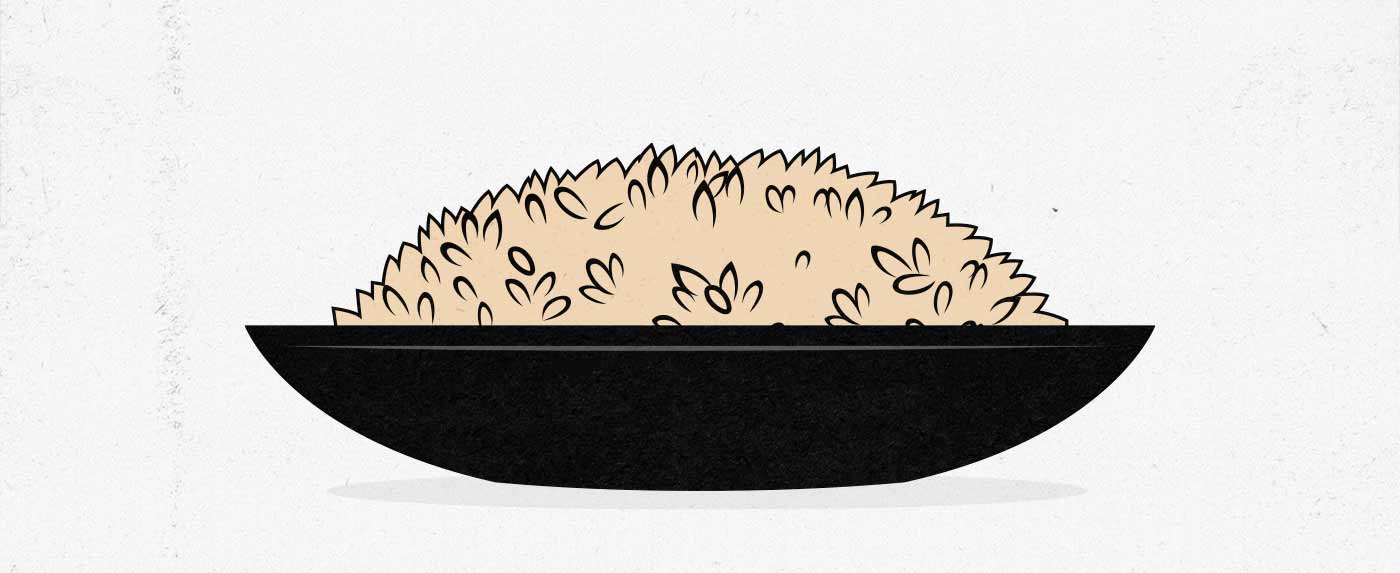
I recommend eating at least 0.7 grams of protein per pound of body weight per day. If you’re trying to bulk leanly, eat enough calories to gain 0.5 pound per week. To build muscle faster, you can gain as much as 1–1.5 pounds per week. For more, we have a full article on how to eat a good bulking diet.
The Best Arm Exercises
We’ve got a whole article about choosing the best muscle-building exercises. To make a long story short, though, there are a few principles that will help you pick good muscle-building exercises:
- Choose exercises that work your muscles in a way that suits their function. For instance, pulling movements are great for your back, less so for your biceps. Curling movements match the function of your biceps better. That’s why they stimulate around twice as much biceps growth.
- Choose exercises that allow you to bring your muscles close enough to failure. Biceps curls are perfect for bringing your biceps close to failure but not for bringing your back close to failure. As a result, curls are great for your biceps, less so for your back.
- Choose exercises that suit your bone structures. We want to stress your muscles, not your joints and tendons. If barbell curls hurt your elbows or wrists, or if they cause tendon pain in your forearms, then it’s better to choose another biceps exercise. Dumbbell curls allow free movement at the wrists and elbows, often solving the problem.
- Focus on exercises that challenge your muscles at longer muscle lengths. Several studies show that you can stimulate more muscle growth by training your muscles at longer muscle lengths, especially if you can stretch them at the bottom of the lift (Pedrosa, Maeo, Oranchuk). So with biceps exercises, incline curls are a powerful exercise because they stretch your biceps. Spider curls, on the other hand, are a poor exercise. After all, they shorten your biceps.
These aren’t hard rules, just guidelines. Plenty of people build big arms simply by doing compound pressing and pulling movements. Even though those exercises aren’t ideal, they’re often enough. So take all of this with a bowl of rice. You don’t need perfection to make progress. If you train at home and don’t have weights, you might need to rely on chin-ups and push-ups to bulk up your arms. That’s okay.
The Best Shoulder Exercises
Your shoulder muscles help you move at the shoulder joint. They only cross that single joint, meaning that compound lifts work very well for bulking them up. If your routine includes some pulling and pressing, your shoulders won’t need much extra attention.
The best shoulder exercises:
- The close-grip bench press (or push-up): great for bulking up your front delts. The advantage to these horizontal presses is that they challenge your front delts under a deep stretch. This makes them ideal for stimulating muscle growth.
- The overhead press: great for bulking up your front and side delts. Overhead presses don’t challenge your shoulders at long muscle lengths, but they have the advantage of training both your front and side delts.
- The chin-up, barbell row and deadlift: great for bulking up your rear delts.
- The lateral raise: great for bulking up your side delts. You don’t necessarily need lateral raises, but they’re simple and easy, and they have the bonus of working your wrist extensors.
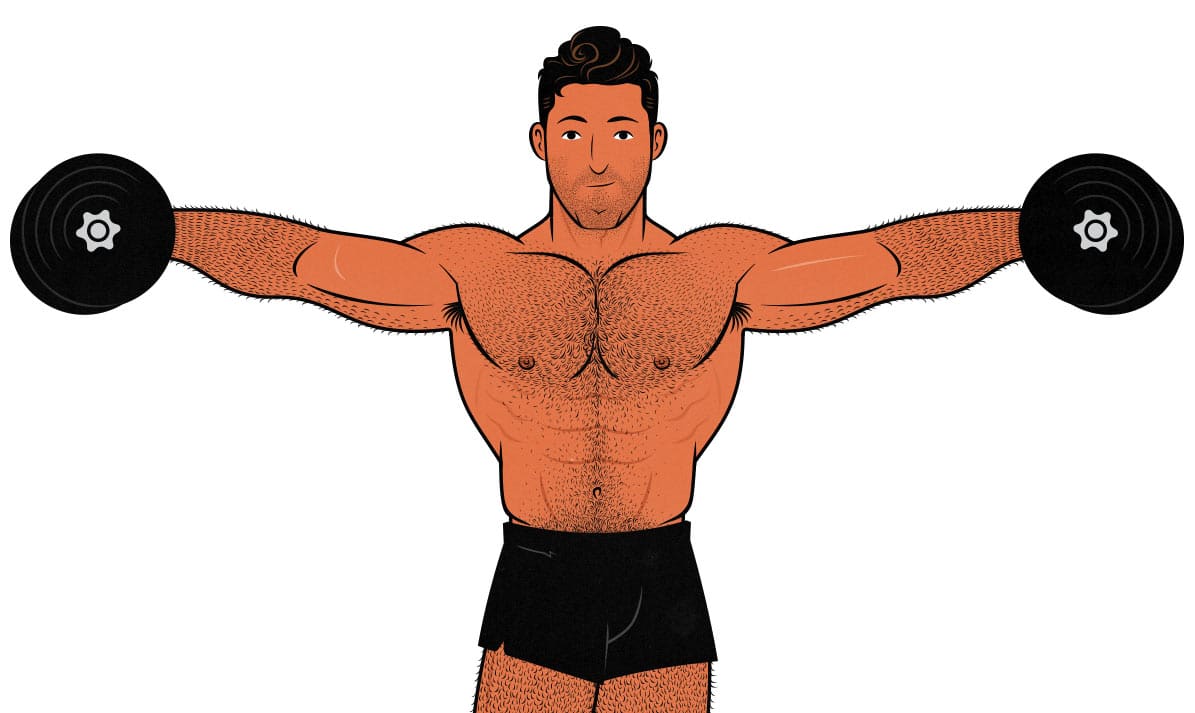
The pulling movements will work the backs of your shoulders (rear delts). The pushing movements will work the fronts of your shoulders (front delts). All those lifts work the sides of your shoulders (side delts) to a certain extent. Still, we can add lateral raises to give them a bit of extra stimulation. For more, we have a full article on shoulder training.
The Best Triceps Exercises
You can stimulate some growth in your triceps by doing compound lifts, especially if your hands are held together by a barbell or the floor. (Dumbbell pressing movements don’t work the triceps very well.) You can make pressing movements even better by using a narrower grip. Close-grip barbell bench presses, barbell overhead presses, and push-ups are good.
But, as we mentioned above, the movement at the shoulder joint interferes with triceps activation, and your triceps probably won’t be the limiting factor. That’s why you’ll want to include triceps extensions as well.
The best triceps exercises:
- The close-grip bench press and overhead press: these pressing movements only stimulate about half as much triceps growth as triceps isolation exercises. But they have the advantage of stimulating your upper chest and shoulders quite well.
- Pushdowns: good for bulking up all the heads of your triceps, but only at moderate muscle lengths. The advantage is that they’re quite easy on the elbows. They make a good beginner triceps exercise.
- Skull crushers: great for bulking up all the heads of our triceps. This is a great default triceps exercise.
- Overhead extensions: ideal for bulking up your triceps but can be quite hard on the elbows. They suit some people better than others.
To fully develop your triceps, pick a big compound lift (like the close-grip bench press) and combine it with your favourite triceps extension, such as the skull crusher.
Your triceps are the largest muscles in your arms. They’re about twice as big as your biceps. So if you want bigger arms, building bigger triceps is a great way to do it. For more, we have a full article on triceps training.
The Best Biceps Exercises
You can build bigger biceps by doing compound lifts, especially if you’re using an underhand or neutral grip. Chin-ups are good for that. But you’ll get even more biceps growth from biceps curls.
The best biceps exercises:
- Chin-ups: great for working your biceps quite hard, though there’s interference at the shoulder joint. As a result, they only stimulate about half as much biceps growth as biceps curls. The advantage is they also work your upper back, rear delts, and grip
- Biceps curls: great for working your biceps without interference at the shoulder joint, making them the perfect default biceps exercise. You can do your curls with dumbbells, barbells, curl bars, or cables.
- Incline curls: this is a special variation of the biceps curl done with a deep stretch of the biceps, making it ideal for bulking up the long head. If you have dumbbells and an adjustable bench, this is a great variation to add to your arm routine.
- Preacher curls: this is a variation of the biceps curl that has a better strength curl. This improved strength curve comes at the cost of training at slightly shorter muscle lengths. Still, it’s a great variation.
To build bigger biceps, combine a big compound lift (such as chin-ups) with a biceps isolation exercise, such as dumbbell curls.
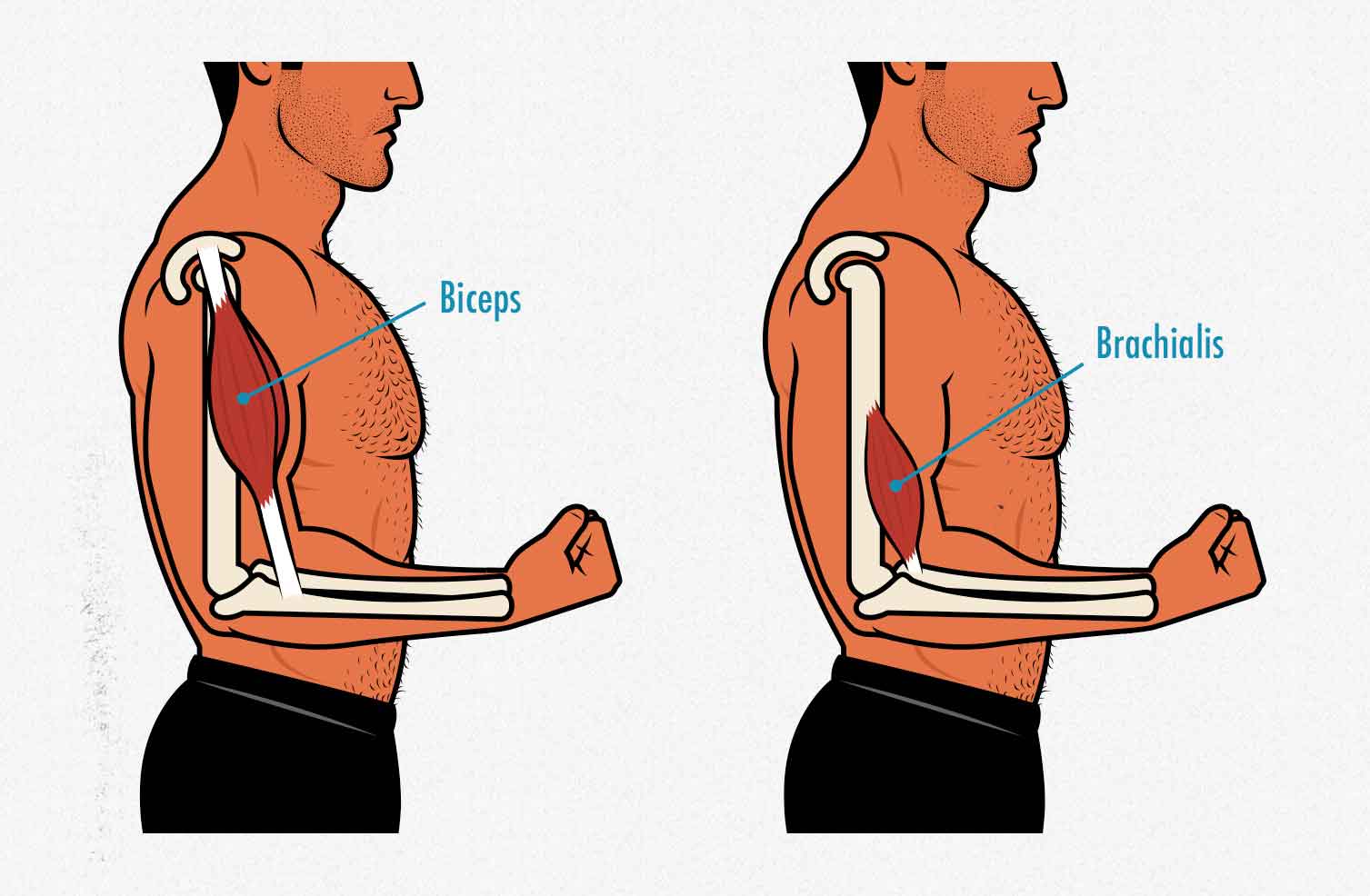
Also, note that your brachialis muscles sit underneath your biceps. If you bulk up your brachialis, they’ll push your biceps out further, increasing your biceps circumference. It’s a simple muscle, though, crossing just your elbow joint. It will grow from compound pulling movements, such as chin-ups and rows. For more, we have a full article on biceps training.
The Best Forearm Exercises
Your forearm muscles will grow even if you don’t train them directly. This is especially true of your elbow flexors. Still, if you want to build bigger forearms, you can greatly speed up the process by training them directly.
You have a slew of different muscles in your forearms. Think of all the muscles that control your fingers. It’s a mess. Bulking up your forearms is quite simple, though. For muscle-building purposes, we can group your forearm muscles into three groups:
- Elbow flexors, trained by pulling movements, biceps curls, hammer curls, and reverse curls.
- Wrist flexors, trained by biceps curls and wrist curls.
- Wrist extensors, trained by lateral raises and wrist extensions.
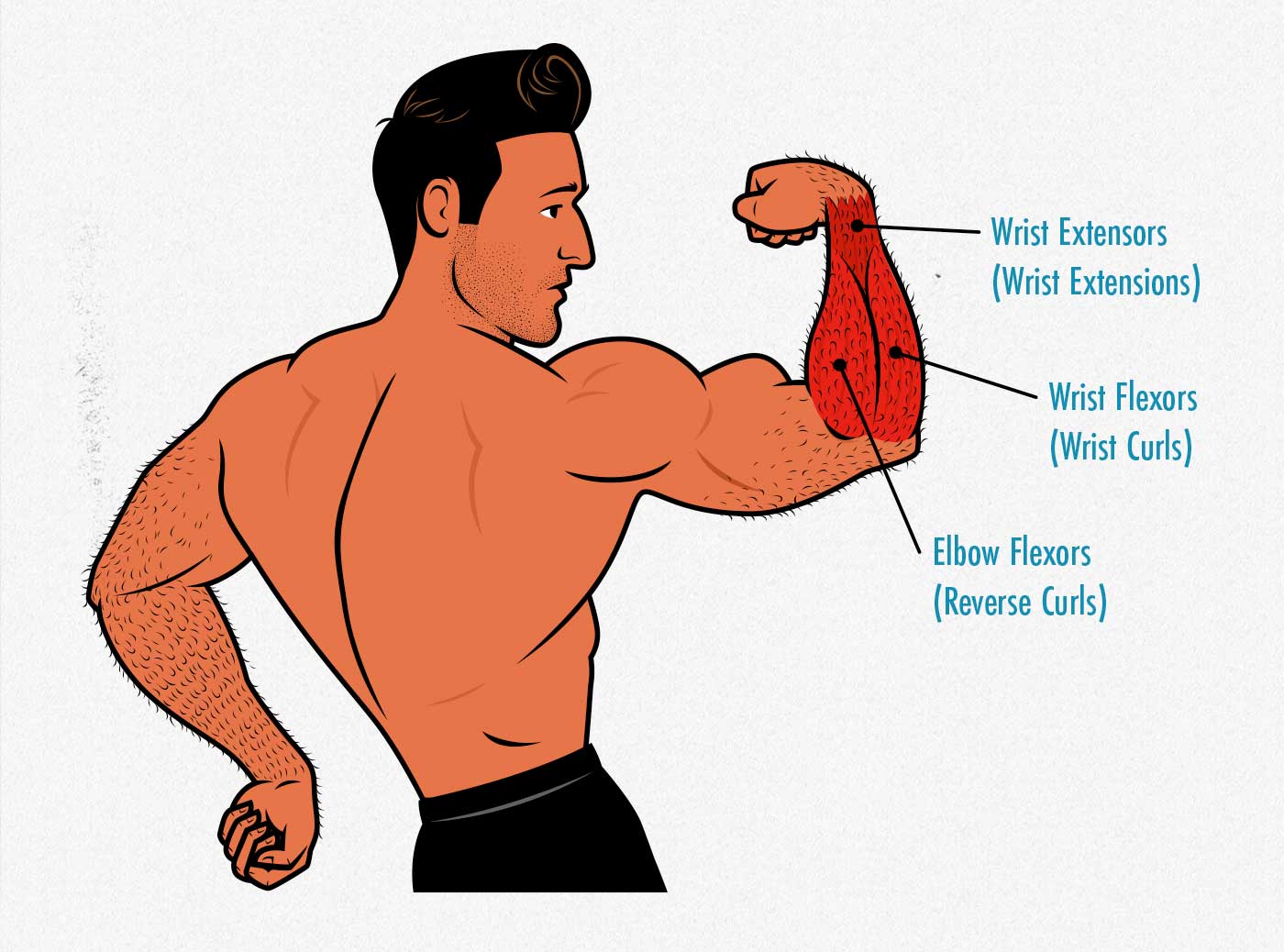
The best forearm exercises:
- Wrist curls: are the heart of forearm training. Your wrist flexors can grow quite large and are often underdeveloped.
- Wrist extensions: aren’t as popular as wrist curls, and your wrist extensors don’t have as much growth potential. Still, they run all along the back of your forearms, and so bulking them up can make your forearms look noticeably thicker.
- Hammer/reverse curls: these usually aren’t needed. Your elbow flexors already get plenty of work, especially if you’re doing compound pulling movements (like chin-ups and rows) and biceps curls.
For more on the best forearm exercises, we have a full article on forearm training.
The Best Arm Workout
You can build bigger arms simply by doing compound lifts, but your progress may be slow and inconsistent, and your arms may lag behind your other muscles. You can remedy this by adding some arm isolation lifts to the ends of your workouts. Maybe one workout ends with biceps curls, another ends with triceps extensions, and another ends with lateral raises. That’s usually enough.
But if you want to emphasize your arms, you can focus 1–2 workouts per week on your arms. Maybe on Mondays and Fridays, you build your workout routine around your arm training. Set aside 1–2 other workouts where you train your other muscles properly. Maybe on Wednesdays, you focus on your deadlifts and squats.
Even with these dedicated arm workouts, we recommend starting with compound lifts. We want to warm up and tire out your muscles so that we aren’t hammering away too hard at your joints with your isolation lifts. And we want to give you results that look balanced, functional, and badass.
Here are some sample arm workouts. Feel free to switch up the exercises. These are just examples.
Barbell Arm Workout
Barbells allow you to lift heavier weights, turning the biceps curl into more of a compound lift. You may find that your upper back, core, and forearms get quite tired by the end of a gruelling, heavy set. And that’s great. The humble biceps curl can be a great exercise for developing your general strength.
The downside is that barbells aren’t designed for curls, so watch out for elbow and forearm tendon pain. Most people don’t have issues, but some do, so it pays to be proactive. If there’s no pain, there’s no problem. But if barbell curls hurt, adjust your grip width and experiment with higher rep ranges. If that doesn’t solve it, consider getting dumbells or a curl bar, allowing you to use a more natural grip position.
Monday barbell arm workout:
- Chin-Ups: 3–4 sets of As Many Repetitions As Possible (AMRAP).
- Overhead Press: 3–4 sets of 6 repetitions.
- Barbell Curls: 2–3 sets of 8 repetitions.
- Overhead Triceps Extensions: 2–3 sets of 12 repetitions.
- Seated wrist curls: 2 sets of 20 reps.
- Seated wrist extensions: 2 sets of 20 reps.
Friday barbell arm workout:
- Close-Grip Bench Press: 3–4 sets of 8 repetitions.
- Barbell Rows: 3–4 sets of 15 repetitions.*
- Skull crushers: 2–3 sets of 12 repetitions.
- Preacher Curls: 2–3 sets of 12 repetitions.
- Seated wrist curls: 2 sets of 20 reps.
- Seated wrist extensions: 2 sets of 20 reps.
*We use a higher rep range on barbell rows so that it becomes an upper-back exercise instead of a hip and lower-back exercise. More on that in our article on barbell rows.
Dumbbell Arm Workout
Barbells often make training more convenient, but that’s not the case with biceps. Dumbbells allow you to work your biceps through a larger range of motion and with freer movement in your wrists and elbows. As a result, you’re less likely to be bothered by cranky joints or tendons.
Monday dumbbell arm workout:
- Chin-Ups: 3–4 sets of As Many Repetitions As Possible (AMRAP).
- Dumbbell Overhead Press: 3–4 sets of 6 repetitions.
- Alternating Dumbbell Curls: 2–3 sets of 12 repetitions.
- Overhead Dumbbell Triceps Extensions: 2–3 sets of 12 repetitions.
- Dumbbell wrist curls: 2 sets of 20 reps.
- Dumbbell wrist extensions: 2 sets of 20 reps.
Friday dumbbell arm workout:
- Push-Ups: 3–4 sets of As Many Repetitions As Possible (AMRAP)
- Dumbbell Rows: 3–4 sets of 15 repetitions.
- Dumbbell Skull crushers: 2–3 sets of 12 repetitions.
- Incline Dumbbell Curls: 2–3 sets of 10 repetitions.
- Dumbbell wrist curls: 2 sets of 20 reps.
- Dumbbell wrist extensions: 2 sets of 20 reps.
Bodyweight Arm Workout
Building bigger arms without weights is fairly simple. You combine pressing movements, such as push-ups and dips, with pulling movements, such as chin-ups and pull-ups. These exercises can all be done without weights. And with just those two movement patterns, your shoulders, biceps, triceps, and forearms will all grow.
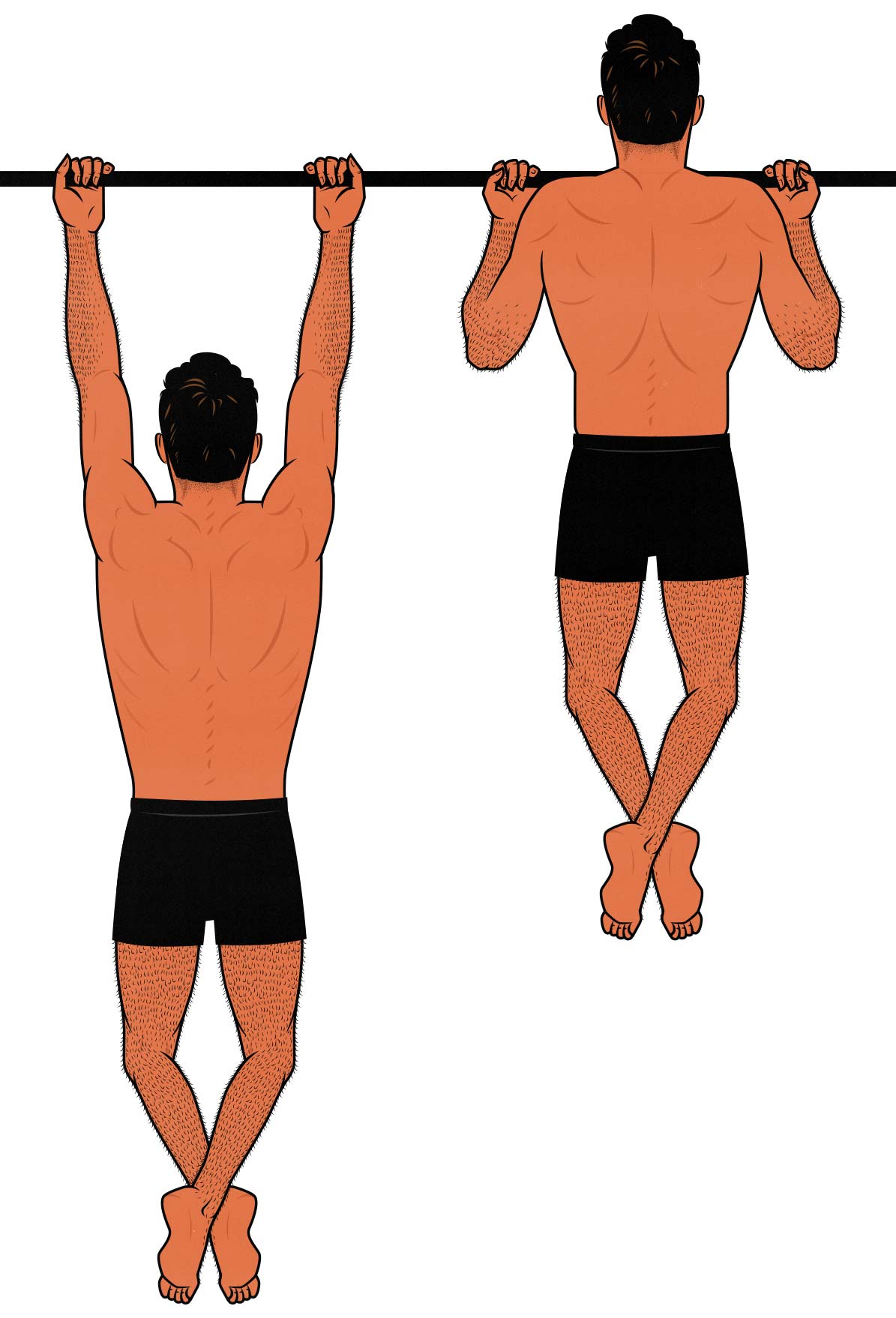
Isolation lifts are better at engaging your arm muscles. Your arms will grow about twice as fast if you train them directly with biceps curls, triceps extensions, wrist curls, and wrist extensions.
The good news is that you don’t need anything. And if you want to double the speed of your arm growth, you don’t need much more. A couple of dumbbells, even if they’re fairly light, can go a long way.
Whatever you have access to, the trick to bodyweight training is lifting within 0–2 reps of failure. Whether that means doing 3 or 40 reps, we need to lift hard enough to stimulate growth. Over time, fight to add more reps.
For more, we have a full article on bodyweight hypertrophy training.
Summary: How to Get Big Arms
To build muscle overall, focus on getting stronger at the big compound lifts. To build bigger arms, add isolation lifts that match the functions of your arm muscles. Focus on getting stronger at those lifts over time, just as you would with your compound lifts.
- Shoulders: overhead press + lateral raises
- Biceps: chin-ups + biceps curls
- Triceps: close-grip bench press + triceps extensions
- Forearms: barbell rows + wrist curls and extensions
Then, follow all of the principles of hypertrophy training:
- Train your arms 2–4 times per week, with twice per week being a great starting point.
- Do 6–20 reps per set, defaulting to 8–15 reps for most arms exercises.
- Do 2–5 sets per exercise, defaulting to 3–4 sets for compound exercises and 2–3 for isolation exercises. Doing one compound and isolation exercise for each arm muscle is plenty.
- Go to failure sometimes. Biceps curls and triceps extensions are quite safe, even when grinding to muscular failure. I recommend stopping just shy of failure on most sets. Take your final set to failure.
- Get stronger at these isolation lifts. Try to add weight or reps every workout. You won’t always be able to, but fight to get stronger over time.
- Remember to eat enough! You need to eat enough protein to build muscle and enough calories to gain weight. Your arm muscles are built out of what you eat.
You don’t need to train your arms this fervently forever. Once you’ve got big arms, you can keep progressing slowly and steadily by getting stronger at the compound lifts. You may as well keep some biceps curls and triceps extensions in your rotation, though.
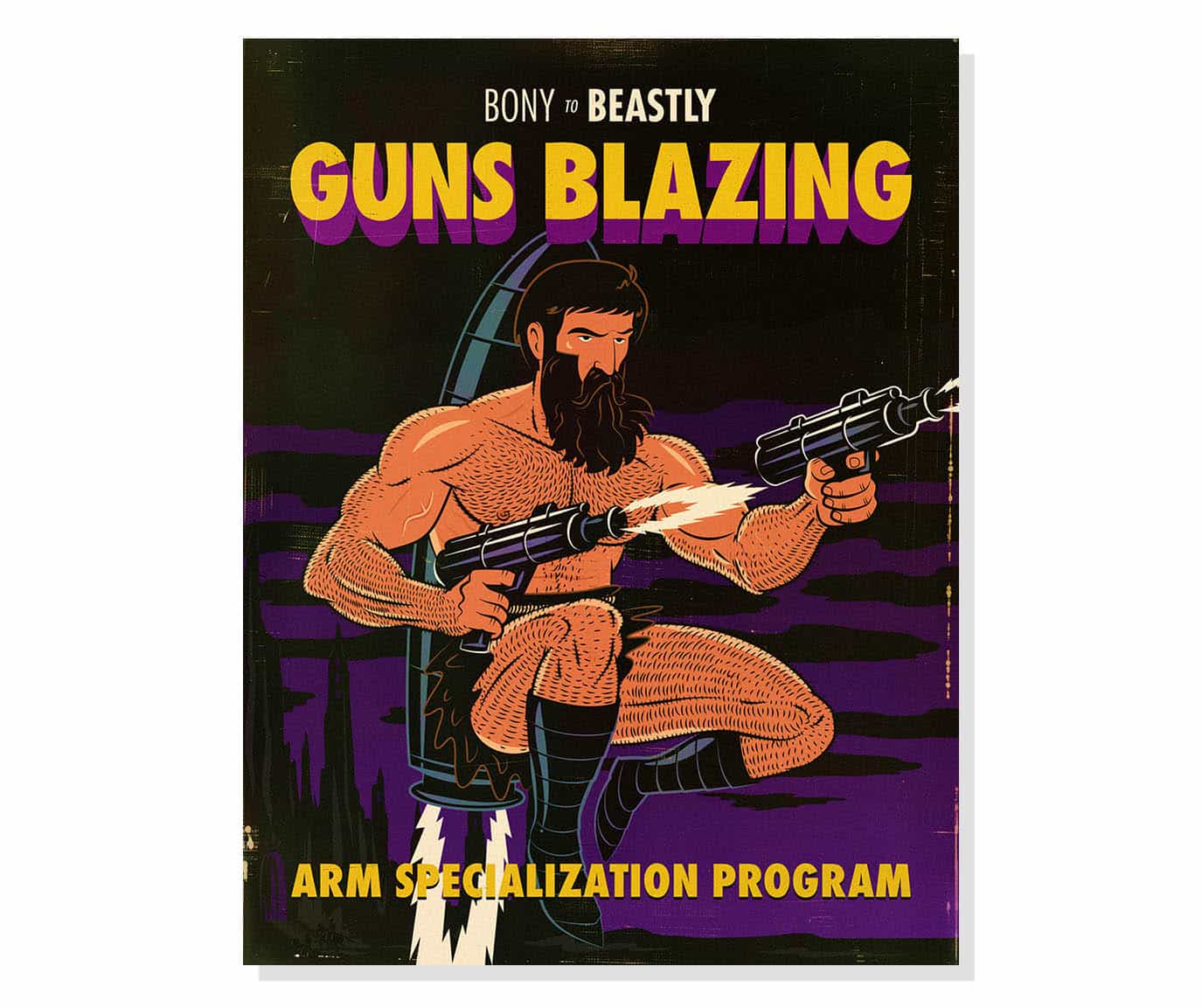
If you want a program that goes after arm growth as aggressively as possible, check out our Guns Blazing Arm Specialization Program. It puts your legs on maintenance, trains your chest and back with a moderate volume (because pressing and pulling exercises work your arms), and puts the vast majority of your effort into building bigger arms.
Muscle-Building Mini-Course via Email
Sign up for our 5-part muscle-building mini-course that covers everything you need to know about:
- Hardgainer genetics and how to make the most of them.
- How to take a minimalist approach to building muscle while still getting great results.
- What you need to know about aesthetics, health and strength while muscling up.



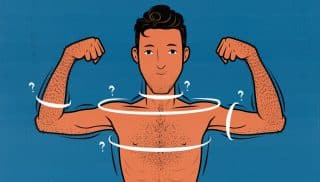
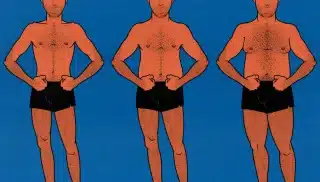
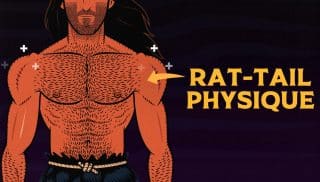
[…] limiting factor on the bench press, you can work them hard enough to stimulate quite a bit of extra arm growth. What’s even cooler is that involving your triceps doesn’t take away from chest […]
For dumbbell tricep extensions, would you recommend doing them with one arm or two arms, (specifically for a beginner/someone out of the gym for years)?
Either one! Or even better: both. Experiment to see which one you prefer. Start with that one. After a couple of months, maybe switch to the other one. That’s what I do. And then switch back again later.
Sounds good, thanks Shane! Before your reply came through, I decided to do one-arm reps. Compared to the two-arm reps, my form was shakier, as expected. But I’ll get the hang of it in the next few weeks.
Have you tried stabilizing your working arm with your other hand? I put my free hand on the triceps that I’m training, keeping the arm steady.
Oof, I didn’t do that; instead I put my free hand on my hip. Thank you Shane for offering that tip, not just for better form but also to avoid any accidents.
Hello Shane! Your example of going from 10 inch to 15,5 inch arms is really inspiring! I have a question: is it correct measure biceps in flexed or relaxed condition? Is formula “Ideal biceps circumference: waist circumference × 0.5” calculated for flexed or unflexed biceps? In which condition did you measured your biceps?
When measuring MY OWN arms, I measure them flexed and without a pump. That’s how it’s usually done in the muscle-building world. Right now they’re at 15.75 flexed.
Thanks. Good luck with building 16 inch arms!
Thank you, man! I’m almost there. 15.75″ and climbing.
Is average 13,3 biceps size indicated for flexed or unflexed biceps?
Normally when people talk about biceps measurements, they’re talking about flexed biceps. But in this case, I think it might have been relaxed. These aren’t muscular 13-inch arms, though. The average person isn’t muscular. I don’t think flexing would make a huge change.
Thanks for the reply, Shane! Probably you are right, if average American is untrained and overweight, then there won’t be much difference between flexed and unflexed arm size. I guess in this case untrained biceps muscle just won’t be able to break through the fat layer.
“Even with these dedicated arm workouts, we still recommend starting with compound lifts.”
Do you mean that, in addition to the exercises you list in the Best Arm Workouts, we should add an additional compound lift at the beginning?
Hey JZ. No, no. Those workouts already start with big compound lifts, such as close-grip bench presses and chin-ups. Those are great exercises to start an arm workout with.
Is it possible for a man with a 6-and-a-half-inch wrists to naturally gain 16-inch arms and 13-inch forearms?
Hey Mark, I think so. There are more factors at play than just the one, but your wrist size shouldn’t make it impossible, just difficult. I’ve got 6.75-inch wrists and I was able to bulk my arms up to 16 inches. I don’t think I’m at my genetic potential. I’m sure I could grow my arms a little bigger. I think you’ll be able to do it, too.
How big are your arms right now?
Shane,
How would you incorporate the dumbbell exercises with the StrongLifts routine? Due to the fact I am lifting on Monday and Friday.
I am 6’5 and skinny, and my arms are really lacking, but I have gained quite a bit on my lower body through StrongLifts.
Is there an average dumbbell weight you would recommend for doing these lifts?
Kind Regards,
Chris
Hey Chris, I’ve got an article on the pros and cons of StrongLifts over on Outlift.
As you’ve noticed, it’s a nice minimalist program that’s good for bulking up the quads, hips, and low back. If you want to bulk up your upper body, I recommend switching to a program that uses more and better upper-body lifts.
If you’re interested in gaining muscle size, I recommend a hypertrophy training program instead of a strength training program.
If you want to keep StrongLifts as a foundation, you’d add biceps curls, triceps extensions, and lateral raises to the end of the workouts. If you don’t have enough time or energy for them, you could cut back to 3–4 sets on your big compound lifts and bump the rep range to 6–12 reps.
If you want to see how a modified StrongLifts routine could look, we’ve got a sample workout routine at the bottom of that StrongLifts article.
It’s hard to recommend a dumbbell weight without knowing how strong you are. You can choose a weight that seems like it might be challenging for a set of 10 reps, then do as many reps as you can with it, taking the set to failure. See how many reps you get.
If you get more than 10 reps, choose a heavier weight and do it again. Keep choosing heavier weights until you fail at 8–10 reps. Start there and work your way up, trying to add weight or reps every workout.
For example, if you get 11, 9, and 8 reps one workout (28 reps), you could try for 29+ reps next workout. When you get 10 reps in that final set, you could add weight. Then add reps until you’re doing 10 reps in the final set again. Keep working your way up, adding weight or reps 🙂
Hello again! I’m doing the dumbbell arm workout. I’m wondering how you might feel about me using a chest press machine instead of the compound exercises (pushups and chin-ups) at the beginning of each workout.
Hey JZ, feel free to use machines instead of compound exercises. They aren’t always perfect replacements, but they’re usually near enough. You can use the chest press machine instead of doing push-ups, though it won’t be as good for your abs and serratus anterior. That isn’t necessarily a problem if those muscles are already strong. You can do lat pulldowns instead of chin-ups. They won’t be as good for your abs, but again, that isn’t necessarily a problem.
Hey Shane, my arms are a weak point and my biceps have issues going heavy – I tend to strain/ injure my elbows when going heavy (10 reps or lower) even with good form (straight wrist, controlled movement, no jerking/ swinging etc)
I am forced to have to do my reps high between 12-20. Will this limit my gains?
Hey Joel, that shouldn’t be a problem.
I like having access to a couple of different rep ranges for variety, though, so maybe you also want to do some work in the 20–30 range. Blood Flow Restriction (BFR) is great for that (article, video). You wouldn’t always need to do it, just if you hit a plateau or want to try something different.
Also, what types of curls are you doing? Dumbbell, barbell, cable, and curl-bar curls can all feel quite different. So can incline, standing, and preacher curls. So, for example, if your elbows hurt when doing heavy barbell curls, you might want to swap them for curl-bar or dumbbell curls. That might feel great on your elbows.
You can also play with volume. If 4 sets of heavy curls hurts your elbows, maybe 1 set doesn’t cause any problems, and it gradually builds up resilience in your elbows. In that case, you could try Pyramid Training, where you start with 15 reps, then 12, then 8. By the time you get to 8, your be tired from the lighter sets, so the weight won’t be as heavy. Plus, your elbows will be nice and warmed up.